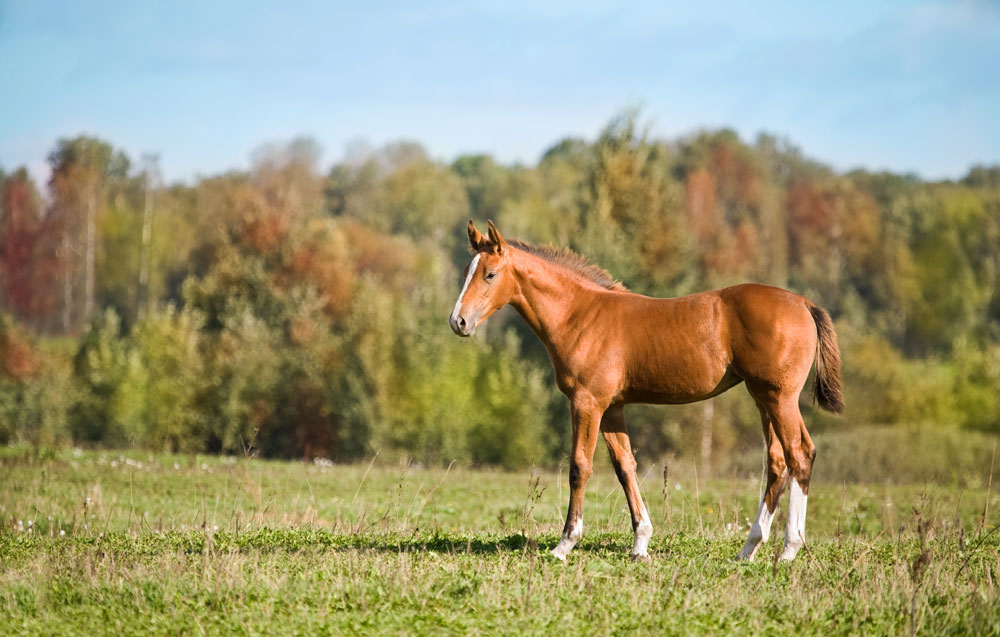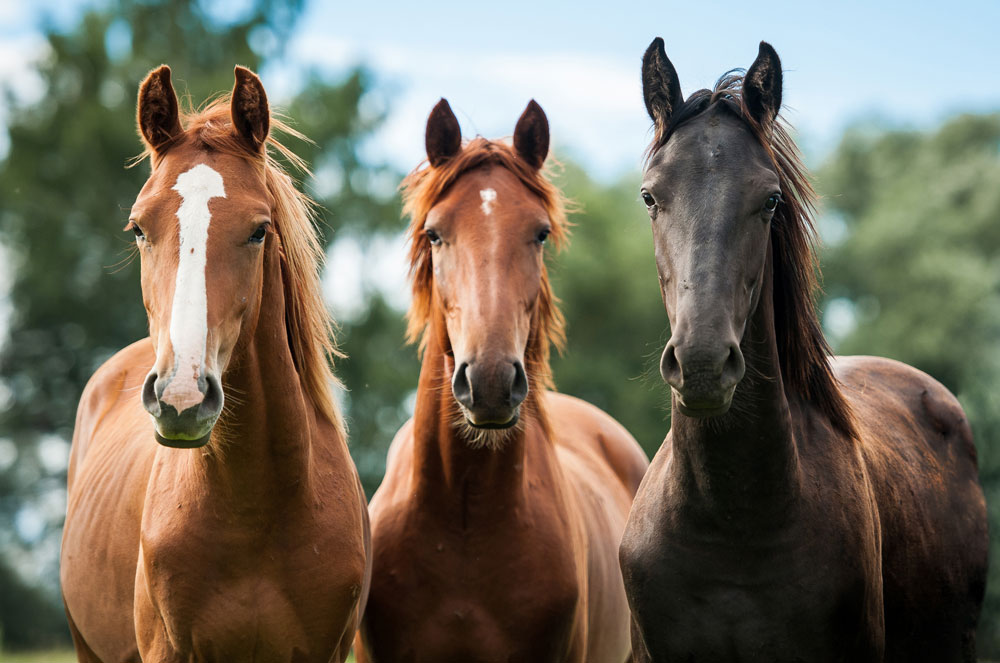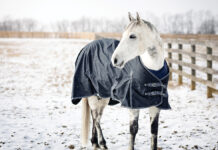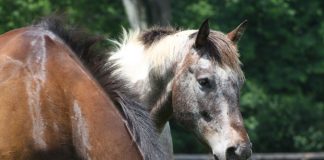In the first five years of life, young horses are prone to a particular set of physical problems. Learn health care tips for young horses.

Although some things are beyond our control, fortunately there are many areas where we can positively influence a horse’s future by laying a solid foundation during his early years.
We sought the advice of professionals in several crucial categories for guidance on what every young horse needs for a healthy start.
Health Care for Young Horses – Nutrition
A pregnant mare needs proper nutrition throughout gestation and lactation in order to have a strong, healthy foal. When her foal is born, the mare’s milk provides 100 percent of his nutritional requirements during the first month. By the time the foal is 3 months old, the protein and energy content of the mare’s milk decreases markedly, but he will already be eating some grass, hay and a small amount of grain by this point.
The greatest rate of growth in the horse’s life takes place during the first 12 months. Proper balanced nutrition is key to building a strong skeletal foundation. If nutrition is compromised during this developmental stage, it’s impossible to make up for it later.
“Most foals are weaned by the time they are 6 months old,” says equine nutritionist Kathleen Crandell, Ph.D., who works with Kentucky Equine Research and has done research on young, growing horses. “[At that point, they] should be eating a concentrate designed for growing horses along with a good quality forage [grass or hay]. Young horses have a higher need for protein, vitamins and minerals than adult horses, so you need to feed a commercial ration designed for growth until they are 2 years old. Then you can switch to a feed formulated for adult horses.”
Since bones are mostly comprised of calcium and phosphorus, these nutrients are critical in the diet of growing horses.
“Young horses are more sensitive to the calcium/phosphorus ratio,” says Crandell. “Alfalfa is very high in calcium and low in phosphorus; in general, an alfalfa/grass hay mix is a more balanced choice for a growing horse than straight alfalfa.”
Crandell notes that it’s important to monitor the growth of young horses. You may have to make adjustments to your feeding program during the first few years of life.
“Keep an eye on the individual horse and don’t over-feed,” she cautions. “If a horse is growing too fast, this can increase the risk of developmental orthopedic disease (DOD), and if a horse is too heavy, this can be hard on joints and overall health.”
If it develops, DOD typically occurs anywhere from weaning age up to about 12 to 18 months. If you notice any signs of lameness or joint tenderness, swelling or heat, call your veterinarian immediately. You will likely have to re-evaluate your feeding program.
Young horses should always have access to trace mineral salt designed for horses. Mineral salt made for livestock is often too low in nutrients to meet the mineral requirements for horses—especially copper—which is important for equine growth.
“With young horses just starting to work, there is some indication in research that using a joint supplement can help prevent future degeneration of joints,” notes Crandell. “This obviously can’t prevent injury, but hopefully can prevent some normal deterioration. A bone supplement may also be helpful.”
Turnout time is essential for health and proper growth, so get those young horses out of the stall.
“Being able to run around is one of the best things for growing bone, as the concussion helps them become stronger,” Crandell adds.
Health Care for Young Horses – Hoof Care
One of the most common mistakes that leads to hoof problems down the road is not having a consistent schedule by a qualified farrier. Whether your horse is barefoot or shod, regular appointments with a hoof care professional are essential.
“A consistent program, including daily cleaning and observation, is always the best thing for feet,” notes Tom Curl, a specialist farrier who focuses on sport horse lameness and is an expert on patching quarter cracks. He travels worldwide to work on challenging cases.
Curl recommends finding a farrier experienced with young horses, as this can help you stay ahead of problems.
“Barefoot is usually a better way to go for younger horses, but once you start getting into a training program, feet need protection to keep the hoof wall from breaking up,” says Curl, who has been a farrier since 1972 and was inducted into the International Horseshoeing Hall of Fame in 2006.
He adds that the nutritional aspect of hoof health is often overlooked. Since nutritional deficiencies invariably show up in a horse’s feet, ask your veterinarian and farrier for advice on creating a nutrition program for your horse’s specific needs. Your farrier may recommend a hoof supplement that includes ingredients to help strengthen hooves and promote growth.
When buying a young horse, pay close attention to his conformation. Curl finds that, unfortunately, it’s common for a horse to have two very different front feet. For example, one may be very upright and the other quite flat. This affects the horse’s way of moving and can present a challenge in keeping the horse sound. Curl has seen this trait in many different breeds.
He urges prospective buyers to have the horse examined by their farrier, not just their vet, during a pre-purchase exam. “If you can’t get past the feet, you won’t get anywhere,” Curl notes. “Four minus one equals zero; that’s farrier math!”

Health Care for Young Horses – Vaccination Program
A pregnant mare should receive booster vaccinations about one month before foaling in order to provide adequate protection to her new baby when he nurses after birth. A properly vaccinated mare will pass on antibodies to her foal, so he won’t need vaccinating until he’s several months old.
The exact age for initial immunization to begin depends on the specific vaccine and risk exposure for your specific area. Your veterinarian is the right person to set up a vaccination program for your horse. You can also educate yourself about vaccine schedules by reviewing the guidelines at the American Association of Equine Practitioners’ website, www.aaep.org.
“Losing a foal for any reason is tragic, but losing one to a disease that you could have prevented is devastating,” says Liz Arbittier, VMD, CVA, a practicing veterinarian and assistant professor in Equine Field Service at the University of Pennsylvania’s New Bolton Center. “If you are uncertain which diseases are prevalent in your area, a conversation with your veterinarian can help identify the vaccines your foal may need.”
Providing a foal has had all the initial doses of vaccines, his immunization schedule once he is a yearling and from then on is typically the same schedule as the adult horses on the same property.
Don’t make the mistake of thinking you can slack off on vaccinations if your horse was properly immunized as a youngster. And when buying a horse, always request documented proof of his vaccination history.
“I frequently see owners who are told that their new horse is vaccinated ‘for everything,’ but when you actually obtain the records, maybe they’ve received one or two vaccines and they are far from covered for that geographic location,” says Arbittier. ”Most animals tolerate vaccines well, so if an owner is uncertain if their animal is vaccinated and we cannot source the veterinary records, I recommend vaccination.”
Don’t assume your horse is safe from disease if you never take him away from home.
“I am always amazed at how disease can travel even to backyard barns where the horses never travel,” says Arbittier. ”Any service professional [farrier, veterinarian, equine lay-dentist, chiropractor, et cetera] can carry disease from barn to barn.”
To keep your horse protected, work with your veterinarian to create and maintain an annual immunization schedule tailored to your region and your individual horse.
Health Care for Young Horses – Dental Care
Schedule a foal’s initial visit with an equine dentist during the first months of life. This allows for the discovery of any issues, such as overbite, also known as “parrot mouth.” If caught early, such malocclusions may be corrected.
“All horses, regardless of age, need an annual exam, as you never know what you will find,” notes Bethany Darrow, DVM, cEqD, a veterinarian near Ocala, Fla., whose entire practice is devoted to equine dentistry.
“Wolf teeth usually erupt by one year of age in both males and females. Often veterinarians will remove wolf teeth from colts when they are castrated. Not all horses will have wolf teeth, but it’s a good idea to check to see if they do,” advises Darrow.
Since wolf teeth don’t fall out on their own, they may need to be removed if there’s a chance they will interfere with the bit. If a horse isn’t going to wear a bridle with a bit, wolf teeth don’t need to be removed.
Young horses lose their baby teeth approximately every six months from 2½ to 4½ years of age.
It’s routine for a riding horse to have his teeth “floated” for the first time before wearing a bit, or when he begins to lose baby teeth, typically around 2½ years of age. Sharp points aren’t routinely floated off until the horse is between 2 and 3 years old.
Each age group of horses has its own unique set of dental concerns. For horses age 1 to 5 years, common issues include sharp enamel points, caps (baby teeth), retained caps, and wolf teeth. A horse doesn’t have a full mouth of adult teeth until the age of 5.
Good dental care now can make a difference in the future.
“If you start early having their mouths properly floated and balanced, there are fewer surprises as horses age,” Darrow observes. “I have seen many properly maintained older horses who have beautiful mouths well into their 30s. It’s unfortunate when I see a geriatric horse whose issues are far too advanced to be helped. If their problems had been properly addressed years earlier, they would not have gotten so out of hand.”
Deworming Guidelines
Another tip for proper health care for young horses is to follow all deworming guidelines. Foals and young horses are more susceptible to infection by different internal parasites and therefore need more frequent deworming than older horses.
“Worm burdens in foals tend to be more diverse than in mature horses,” says Craig R. Reinemeyer, DVM, Ph.D., Dipl. ACVM, a veterinary parasitologist and president of East Tennessee Clinical Research, Inc. in Rockwood, Tenn.
Foals require deworming at various intervals during their first year of life, starting when the foal is 2½ to 3 months of age. Most foals would benefit from a second deworming for ascarids at around 8 months of age.
Deworming during this year should mainly target ascarids (roundworms), so make sure to use a product that is effective against them. As the foal matures, ascarid infections become less common because he develops immunity against that parasite if he’s been properly dewormed against ascarids from an early age.
Once the horse is older than 18 months, small strongyles become the major parasite of concern. During the horse’s second year of life, three dewormings should be adequate.
Reinemeyer recommends that two of those treatments be scheduled about six months apart, using a dewormer that targets large strongyles. He advises giving the third treatment during the main parasite transmission season, which will vary by climate region (summer in the north; winter in the south).
Through the horse’s third year, plan on deworming three times a year at the same basic intervals as when he was a 2-year-old.
Once your horse is 4 years of age, you can begin using fecal egg count (FEC) tests and fecal egg count reduction tests (FECRT) to create a strategic deworming program for him as an individual. This helps avoid unnecessary deworming and thereby reduces the rate of parasite resistance to anthelmintics (deworming drugs).
FEC tests measure the number of strongyle eggs passed per gram of manure. Comparison of egg counts within the whole herd determine whether your horse is a high, medium or low shedder, allowing you to deworm him accordingly. These tests don’t detect the presence of tapeworms. Your veterinarian can recommend specific treatment for tapeworms, which is commonly done in the fall.
If you have questions or concerns about deworming young horses, discuss them with your veterinarian.
Training and Soundness
The last tip for proper health care for young horses is to keep up with training programs and look out for your horse’s soundness. You want to look forward to a lifetime of riding together, so use wisdom when starting your horse’s training routine.
“The most common mistake is excessive high-impact work with the young horse,” says Mark R. Baus, DVM, of Grand Prix Equine, a New York-based veterinary service dedicated to equine athletes. “I regard cantering and jumping as high-impact work and prefer that the activity for young horses concentrate on the slower gaits, especially with a rider.”
Baus doesn’t discourage longeing or round-pen work, provided it’s not excessive.
“Footing is extremely important when working the young horse,” he adds. “In my experience, too deep is more harmful than too firm. Also, to help mitigate the effects of poor footing, leave young horses unshod for as long as possible.”
Before beginning a riding career, Baus says an important—and often overlooked—consideration is to identify the young horse’s weaknesses.
“A thorough examination, preferably with radiographs, would help identify areas of concern and how rapidly the training process can progress,” says Baus. “Oftentimes, there is an impediment to training that is explained by a physical problem that could have been identified. Once identified, this finding could be treated or the training process modified to allow for it.”
Baus points out that while most horses can handle a full work load by age 5, they will still lack the training and experience to perform at higher levels.
This article originally appeared in the October 2018 issue of Horse Illustrated magazine. Click here to subscribe!





